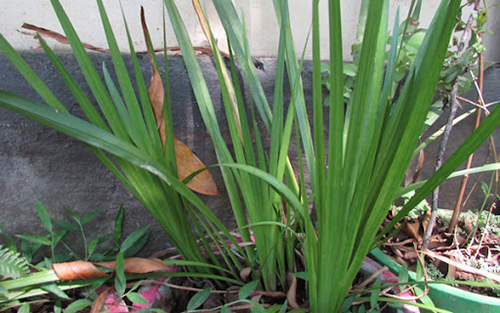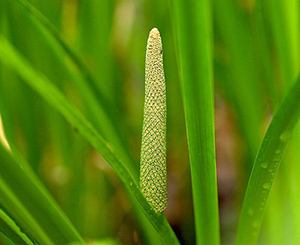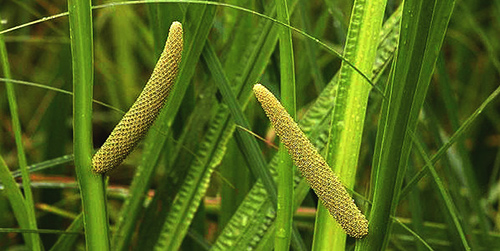Contents
The sweet flag plant is native to Asia and was brought to Europe in the 13th century by the Tartars. It has a pleasant smell, which resembles mandarin oranges; however, it has a sour taste. In Arabic countries, its essence is used as an aphrodisiac.
- Sweet tasting, with flavours similar to a mixture of cinnamon, nutmeg and ginger – although watch out for the bitter aftertaste.
- Perfect as a tea, flavouring for food or as bitters.
- If you don’t enjoy the bitter aftertaste of this calamus root tea, you can always mix in a spoonful of honey.
Sweet Flag Scientific Facts

- Other names: Calamus, grass myrtle, myrtle flag, sweet grass, sweet myrtle, sweet rush.
- French: Acore.
- Spanish: Calamo aromatico.
- Environment: It grows along the borders of marshes and river banks in Europe, North America, and Argentina. Widespread, but not very common.
- Description: Water plant of the Araceae family, which grows from 60 to 150 cm high, with lanceolate, narrow leaves, and flowers growing in cylindrical spikes.
- Parts of the plant used medicinally: The rhizome (underground stem).
Healing Properties and Warning

Sweet flag rhizome contains an essential oil, Oleum calami, to which the plant owes its medicinal properties. These are as follows:
- Appetizer: It increases appetite.
- Eupeptic: (Promotes digestion). It is helpful for a bloated stomach, a lack of gastric juice (hypochloridria), and chronic gastritis.
- Carminative: Sweet flag eliminates gas in the digestive tract.
- Muscular relaxing and mildly sedative in the nervous system, when externally applied, adding its decoction to hot bathwater. It alleviates rheumatic pain and aids sleeping.
- Eases skin itching for rashes and nettle rash. A bath with a decoction of sweet flag root relieves itching and soothes the skin.

WARNING! The continuous administration of cis-isoasarone (one of the components of the essential oil of the sweet flag) to experimental animals, can produce toxic effects of a mutagenic type. As a precautionary measure, the prolonged internal use of sweet flag (for more than one month) should be avoided, or better still, pharmacological preparations of sweet flag oil, which have the cis-isoasarone removed, should be used.
How to use Sweet Flag
- Decoction or infusion with a tablespoonful of ground rhizome (some 15g) per cup of water. Drink two or three daily cups. Do not sweeten.
- Baths: Add to the bathwater a decoction prepared with 500g pf ground rhizome per liter of water.
DISCLAIMER: All content on this website is presented solely for educational and informational objectives. It would be best to not rely on the information provided as a replacement for advice, diagnosis, or treatment from a qualified medical expert. If you are pregnant, nursing, or have any preexisting medical concerns, you should talk to your doctor before using any herbal or natural medicines.
REFERENCES
- George D. Pamplona-Roger, M.D. “Encyclopedia of Medicinal Plants.” George D. Pamplona-Roger, M.D. Encyclopedia of Medicinal Plants. Ed. Francesc X. Gelabert. vols. 2 San Fernando de Henares: Editorial Safeliz, 2000. 424. Print.
- Singh, B., & Sharma, R. A. (2015). Acorus calamus L. (Sweet flag): A review on its phytochemistry, pharmacological and toxicological aspects. Scientific World Journal, 2015, 1-14.
- Dhingra, D., & Kumar, V. (2008). Memory-enhancing activity of palmatine in mice using elevated plus maze and Morris water maze. Advances in Pharmacological Sciences, 2008, 1-4.
- Srivastava, S., & Lal, S. (2012). Traditional wisdom and value addition prospects of Acorus calamus Linn.: An overview. Journal of Medicinal Plants Research, 6(33), 4673-4680.
- Kumar, V., & Singh, P. N. (2018). Pharmacological potential of Acorus calamus: A review on its medicinal properties. Pharmacognosy Reviews, 12(23), 112-118.
- Khan, R., Islam, B., Akram, M., Shakil, S., Ahmad, A., Ali, S. M., & Siddiqui, M. (2016). Antimicrobial activity of five herbal extracts against multi drug resistant (MDR) strains of bacteria and fungus of clinical origin. Molecules, 21(1), 1-11.
- Patel, S., Sharma, V., Chauhan, N. S., & Thakur, M. (2011). Acorus calamus: An overview. Journal of Pharmacy Research, 4(10), 3050-3053.
Last update on 2025-04-18 / Affiliate links / Images from Amazon Product Advertising API





